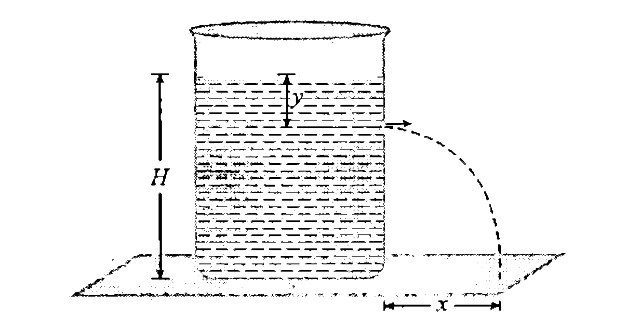A fixed container of height H with large cross-sectional area A is completely filled with water. Two small orifice of cross-sectional area a are made, one at the bottom and the other on the vertical side of the container at a distance H/2 from the top of the container find the time taken by the water level to reach a height of H/2 from the bottom of the container.
_S01_033_S01.png)
V1=√T(2g(h−H/2)),V2=√2gh∴ By continuity equation
A(−dhdt)=a(V1+V2)⇒A(−dhdt)=a{√2g(h−H/2)+√2gh}
or −Aa√2gH/2∫Hdh√h+√h−H/2=t∫0dt⇒t=2A3a(√2−1)√Hg
Topper's Solved these Questions
- ELASTICITY, SURFACE TENSION AND FLUID MECHANICSBook:ALLENChapter:ELASTICITY, SURFACE TENSION AND FLUID MECHANICSExercise:Exercise 1 (Elasticity)
Explore 16 Videos
- ELASTICITY, SURFACE TENSION AND FLUID MECHANICSBook:ALLENChapter:ELASTICITY, SURFACE TENSION AND FLUID MECHANICSExercise:Exercise 1 (Surface Tension)
Explore 21 Videos
- CENTRE OF MASSBook:ALLENChapter:CENTRE OF MASSExercise:EXERCISE-V B
Explore 19 Videos
- ERROR AND MEASUREMENTBook:ALLENChapter:ERROR AND MEASUREMENTExercise:Part-2(Exercise-2)(B)
Explore 22 Videos
Similar Questions
A cylindrical vessel of area of cross section A is filled with a liquid up to a height H. A very small hole of area of cross section a is made at the bottom of the vellel. Find the time taken by the vessel to become empty.
View SolutionA cylindrical massless container of cross sectional area A have a fluid filled up to height h and have a small orifice of area a in wall near its bottom. Find minimum coefficient between container and ground so that container does not move
View Solution
Knowledge Check
Water rises to a height h in a capillary tube of cross-sectional area A. the height to which water will rise in a capillary tube of cross-sectional area 4A will be
AhBh/2Ch/4D4hA water tank of height H, completely filled with water is placed on a level ground. It has two holes one at a depth h from top and the other at height h form its base. The water ejecting from
Aboth the holes will fall at the same spotBupper hole will fall farther than that form the lower holeCupper hole will fall closer than that form the lower holeDmore information is required.A tank, which is open at the top, contains a liquid up to a height H. A small hole is made in the side of the tank at a distance y below the liquid surface. The liquid emerging from the hole lands at a distance x from the tank :
 A2√h(H−h)B√h(H−h)C2√h2H−hD√h2H−h
A2√h(H−h)B√h(H−h)C2√h2H−hD√h2H−h
A cylindrical tank of cross sectional area a1 is filled with water to a height h. A hole of cross sectional area a2 is made at the bottom. If a1=5a2, then find the
(i) initial velocity with which the water falls in tank.
(ii) initial velocity with which water emerges out from hole.
(iii) time taken to make the tank empty.
View SolutionA large open top container of negligible mass and uniform cross-sectional area A has a small hole of croos-sectional area A100 in its side wall near the bottom.The container is kept on a smooth horizontal floor and contains a liquid of density ρ and mass m0. Assuming that the liquid starts flowing out horizontally through the hole at t=0, The acceleration of the container is x10m/s2 than x is -
View SolutionIn a container, filled with water upto a height h, a hole is made in the bottom. The velocity of water flowing out of the hole is
View SolutionA container of height 10m which is open at the top, has water to its full height. Two small openings are made on the walls of the container one exactly at the middle and the other at the bottom. The ratio of the velocities with which water comes out from the middle and the bottom region respectively is
View SolutionA cylindrical tank having cross-sectional area A is filled with water to a height of 2.0 m. A circular hole of corss-section area is opened at a height of 75 cm from the bottom. If a/A=√0.2, then velocity with which waer emerges from the hole is
(g=9.8ms−2)
View Solution

